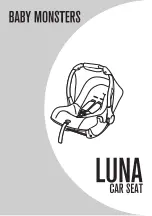
Page 24
Locking the Lap-Shoulder Belt
·
The three options discussed on
pages 25-29 describe how to install
this restraint with a combination lap
and shoulder belt only. They do not
apply to “lap belt” installations.
·
Since the user has the option of us-
ing the “long” (see pages 30-33) or
short (see pages 34 and 35) belt
paths when using a lap and shoulder
belt, there are two Figures for each
step on the following pages. “L”
denotes the “long” belt path and “S”
denotes the “short” belt path.
·
There are three primary methods
for locking a lap-shoulder belt. It is
important to know the correct way
to lock your vehicle’s lap-shoulder
belt in order to ensure a safe instal-
lation of this restraint.
·
Review your owner’s manual to de-
termine if your seat belt is designed
to lock child restraints in place.
·
While there may be exceptions,
1996 model year vehicles or newer
should have either a locking latch
plate (Figure A) or a switchable re-
tractor (Figure B).
Note: Pages 25-29 describe how to lock a lap-shoulder
belt. First, install the restraint using one of the
installation methods described on pages 30-41. If you
used a lap-shoulder belt to install the restraint, then
return to this section to determine how to lock it.
C
A
B
·
If your vehicle’s lap-shoulder belt is equipped with an
emergency locking retractor, then the locking clip (Figure
C) provided will have to be used.













































